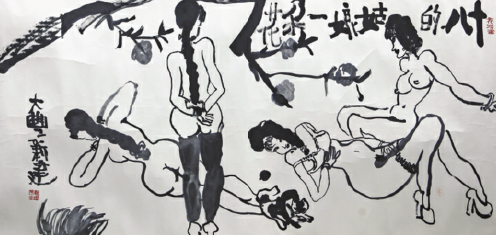
The 18-year-old Girls, by Zhu Xinjian.[CHINA DAILY]
Zhu Xinjian (1953-2014) said he once decorated his scrapbook with a painting by Qi Baishi (1864-1957), which he cut out from newspapers, together with a photo of naked women. By doing so, he wished to use the free, lofty brushwork of Chinese painting, which ancient literati employed to portray landscape and aloofness, to express lust as a fundamental desire of mankind that earlier painters normally shunned.
Considered shameless by some and genuine by others, Zhu had painted human's basic needs, sex in particular, for more than two decades. He is most famous for portraying nude modern beauties with rough-sometimes exaggerated-strokes of ink.
A representative of the "New Literati Painting" movement, he stripped the hypocrisy and pretense of literati painting traditions and enlivened the art school with a playful and down-to-earth approach.
Two months after he died of lung cancer earlier this year, Zhu's first major solo exhibition was opened at the Today Art Museum, displaying his some 200 Chinese paintings, calligraphy scrolls, manuscripts and sketches.
The Modern Recluse: Hermit Spirits of Zhu Xinjian exhibition has a Chinese title of distinctive Zhu style which reads, "Live Like an Immortal, Except for Eating". (Fairies were described as not needing to eat or drink by ancient Chinese.)
Zhu wrote the phrase in calligraphy and picked it as the exhibition's theme. He didn't intend to lead a life disconnected from the world like fairies do, but to live as lightheartedly as they would.
The works on show include Zhu's signature Jin Ping Mei (The Plum in the Golden Vase) leaf album, which was inspired by the Ming Dynasty (1368-1644) novel of the same name, along with his other erotic paintings.
He gave explicit depictions of sexuality and nudity, sourcing inspiration from traditional nianhua (Chinese New Year paintings) and ancient erotic art. He put them in a setting with plants and potted landscapes, which are normally portrayed as symbols of elegance and pride in classic Chinese painting.
He also used slang and lyrics of pop music as annotations on his erotic works, figures or flowers and birds. This innovation was imitated by other New Literati painters.
